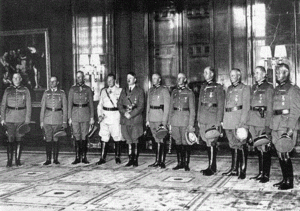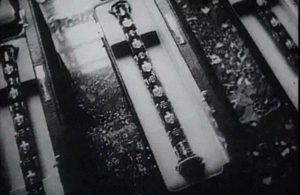1940 Field Marshal Ceremony

The 1940 Field Marshal Ceremony refers to a promotion ceremony held at the Kroll Opera House in Berlin in which Adolf Hitler promoted twelve generals to the rank of Generalfeldmarschall ("field marshal") on 19 July 1940. It was the first occasion in World War II that Hitler appointed field marshals due to military achievements.
The prestigious rank of field marshal had been banned after the First World War. As part of the Nazi expansion of the military, the rank was revived. Hitler promoted twelve selected generals to field marshal during the ceremony in Berlin for their role in the swift victory over France and the Low Countries and to raise morale. The ceremony highlighted the power and prestige of the Wehrmacht; France was considered to have had the strongest army in Europe, yet had been humiliatingly defeated in just six weeks.
The ceremony was the first time Hitler appointed field marshals due to military achievements and was celebrated like no other promotion ceremony of the war.
Field marshal
After World War I, the prestigious and respected rank of field marshal was banned, alongside other military restrictions imposed on the newly formed Weimar Republic. After Hitler and Nazis came to national power in January 1933, they began an enormous expansion of the military; it was part of Hitler's desire to restore the army's power and prestige.[1] In 1936, he revived the rank of field marshal. It was the highest and most prestigious military rank in Germany, originally only for the use of the Minister of War and Commander-in-Chief of the Army.[2] The traditional attribute distinguishing a German field marshal was an ornately decorated baton.[3] More tangible benefits included a yearly salary of 36,000 Reichsmarks and all earnings being exempt from income tax.[4]
Ceremony
Flushed with enthusiasm by the swift defeat of the French army, considered to have been the strongest in Europe,[5] and the Low Countries in June 1940, Hitler wanted to mark the occasion with a grand promotion ceremony.[6] He also hoped the promotions would strengthen his influence over the traditional German General Staff.[7] The twelve generals chosen for promotion, who all had played an important role in the victory, were:
- Colonel General Walther von Brauchitsch[8]
- Colonel General Fedor von Bock[9]
- General Albert Kesselring[10]
- Colonel General Wilhelm Keitel[11]
- Colonel General Günther von Kluge[12]
- Colonel General Wilhelm von Leeb[13]
- Colonel General Wilhelm List[14]
- Colonel General Erhard Milch[15]
- Colonel General Walther von Reichenau[16]
- Colonel General Gerd von Rundstedt[17]
- General Hugo Sperrle[18]
- Colonel General Erwin von Witzleben[19]
Additionally, Field Marshal Hermann Göring, head of the Luftwaffe, was promoted to the specially-created rank of Reich Marshal of the Greater German Reich, a newly created rank that not only made Göring the senior officer of the military, but also confirmed an earlier Hitler decree naming Göring his successor. This was the only award of this rank during the Nazi era, and it was abolished after the fall of the Nazi regime. [20] [21]

On 19 July 1940, Hitler summoned the generals to a ceremony in Berlin's Kroll Opera House (which housed the Reichstag after the Reichstag fire).[22][23][6] After a speech regarding a peace proposal directed at Britain, Hitler personally rewarded his generals with their expensively decorated batons,[22][3] and thanked them for their contributions to the victory.[24][25][lower-alpha 1]
The 1940 Field Marshal Ceremony was the first occasion Hitler appointed field marshals due to military achievements and was celebrated like no other promotion ceremony in Germany.[6][26] The remaining five years of the war saw an additional twelve promotions, most of which were without ceremony, such as Friedrich Paulus's promotion, which was conferred over the radio by Hitler.[27][8][lower-alpha 2]
Aftermath
All of the generals promoted would go on to achieve further success in their careers during the early years of victory which the German military obtained in the Second World War. Brauchitsch, Bock, Kesselring, Keitel, Leeb, List, Reichenau, Rundstedt, and Göring would all play decisive and important roles in the German-led Axis invasion of the Soviet Union in 1941.[28] Sperrle spent the rest of the war in semi-retirement, based with his unit in France.[18] Milch was transferred to the production department and was responsible for aircraft production until the end of the war. In 1943, after a series of German defeats on the Eastern Front, and the Allied invasion of Italy, the German military lost all initiative.[5] Hitler's leadership became increasingly disconnected from reality as the war turned against Germany, with the military's defensive strategies often hindered by his slow decision making and frequent directives to hold untenable positions.[5] His response to the worsening war situation was to unceremoniously sack general after general, a routine which ultimately affected the field marshals promoted at the ceremony.[5] Erwin von Witzleben and Günther von Kluge were both involved in the 20 July Plot to assassinate Hitler. After it became clear that the assassination attempt had failed, Kluge committed suicide by taking cyanide poison on 17 August 1944.[12] Witzleben, who was to become Commander-in-Chief of the Wehrmacht if the attempt had succeeded, was arrested and sentenced to death; the execution was carried out on 8 August 1944.[29]
See also
Footnotes
- ↑ Hermann Göring had already been promoted field marshal in 1938 and was instead promoted to Reichsmarschall, and was the only one to have held this rank.[30]
- ↑ In deciding to promote Paulus during the Battle of Stalingrad, Hitler noted that there was no known record of a Prussian or German field marshal ever having surrendered. The implication was clear: Paulus was to commit suicide. If Paulus surrendered, Hitler implied he would shame Germany's military history. Paulus, nevertheless, surrendered to Soviet forces on 31 January 1943, the day after he was promoted.[8]
References
- ↑ Weinberg 1970, pp. 26–27.
- ↑ Hakim 1995, pp. 100–104.
- 1 2 Alford 2003, pp. 66–67.
- ↑ Snyder 1994, p. 111.
- 1 2 3 4 Rees 2012.
- 1 2 3 Mitcham 2009, p. 24.
- ↑ Snyder 1994, pp. 111–112.
- 1 2 3 Snyder 1994, p. 112.
- ↑ Turney 1971, p. 6.
- ↑ Kesselring 1970, p. 55.
- ↑ Sandler 2002, p. 455.
- 1 2 Moczarski 1981, pp. 226–234.
- ↑ Shirer 1960, p. 647.
- ↑ Williamson 2006, p. 28.
- ↑ Snyder 1994, p. 229.
- ↑ Biesinger 2006, p. 619.
- ↑ Mackenzie 2014, p. 17.
- 1 2 Williamson 2006, p. 46.
- ↑ Mitcham 2009a, pp. 1–2.
- ↑ Rise and Fall of the Third Reich, by William L. Shirer. Published 1960.
- ↑ Manvell 2011, p. 245.
- 1 2 Deighton 2008, pp. 7–9.
- ↑ Evans 2008, pp. 122–123.
- ↑ Dear & Foot 2005, p. 322.
- ↑ Ellis 1993, p. 94.
- ↑ Tague 2011, p. 150.
- ↑ Beevor 1998, p. 381.
- ↑ Grazhdan 2011.
- ↑ Snyder 1994, p. 382.
- ↑ Fellgiebel 2000, p. 198.
Sources
- Alford, Kenneth D. (2003). Nazi Plunder: Great Treasure Stories Of World War II. Da Capo Press. ISBN 978-0306812415.
- Beevor, Antony (1998). Stalingrad: The Fateful Siege, 1942–43. Viking Press. ISBN 978-0-670-87095-0.
- Biesinger, Joseph A. (2006). Germany: A Reference Guide from the Renaissance to the Present. Facts on File. ISBN 978-0816045211.
- Dear, I.C.B.; Foot, M.R.D., eds. (2005) [1995]. The Oxford Companion to World War II. Oxford University Press. ISBN 978-0-19-280666-6.
- Deighton, Len (2008). Fighter: The True Story of the Battle of Britain. Random House. ISBN 978-1-84595-106-1.
- Ellis, John (1993). World War II Databook: The Essential Facts and Figures for All the Combatants. Aurum. ISBN 1-85410-254-0.
- Evans, Richard J. (2008). The Third Reich At War. Penguin Group. ISBN 978-0-14-311671-4.
- Forczyk, Robert (2010). Manstein: Leadership – Strategy – Conflict. Osprey. ISBN 978-1-84603-221-9.
- Fellgiebel, Walther-Peer (2000). Die Trager Des Ritterkreuzes Des Eisernen Kreuzes, 1939–1945. Podzun-Pallas. ISBN 978-3-7909-0284-6.
- Hakim, Joy (1995). A History of Us: War, Peace and all that Jazz. Oxford University Press. ISBN 0-19-509514-6.
- Kesselring, Albert (1970). A Soldier's Record. Greenwood Press. ISBN 0-8371-2975-3.
- Knopp, Guido (1998). Hitler's Warriors: Manstein The Strategist. ZDF. Retrieved 23 July 2014.
- Grazhdan, Anna (2011). Soviet Storm: World War II in the East. Channel One Russia. Retrieved 7 November 2014.
- Rees, Laurence (2012). The Dark Charisma of Adolf Hitler. BBC. Retrieved 30 June 2014.
- Manvell, Roger (2011) [1962]. Goering. Skyhorse. ISBN 978-1-61608-109-6.
- Mackenzie, Simon P. (2014). The Second World War in Europe: Second Edition. Routledge Publishing. ISBN 978-1317864714.
- Melvin, Mungo (2010). Manstein: Hitler's Greatest General. Weidenfeld & Nicholson. ISBN 978-0-297-84561-4.
- Mitcham, Samuel Jr. (2009). Men of Barbarossa – Battles and Leaders of the German Invasion of Russia, 1941. Casemate Books. ISBN 978-193-514-9156.
- Moczarski, Kazimierz (1981). Conversations With an Executioner. Prentice-Hall. ISBN 0-13-171918-1.
- Mitcham, Samuel Jr. (2009a). Defenders of Fortress Europe: The Untold Story of the German Officers During the Allied Invasion. Potomac Books Inc. ISBN 978-1597972741.
- Sandler, Stanley (2002). Ground Warfare: An International Encyclopedia, Bind 1. ABC-Clio. ISBN 978-1576073445.
- Shirer, William L. (1960). The Rise and Fall of the Third Reich. Simon & Schuster. ISBN 978-0-671-62420-0.
- Snyder, Louis (1994) [1976]. Encyclopedia of the Third Reich. Da Capo Press. ISBN 978-1-56924-917-8.
- Turney, Alfred W. (1971). Disaster at Moscow: von Bock's Campaigns 1941–42. Cassell & Co. ISBN 0-826-3-01-673.
- Tague, James E. (2011). The Last Field Marshal. Author Solutions. ISBN 978-145-683-185-1.
- Williamson, Gordon (2006). German Commanders of World War II. Osprey Publishing. ISBN 1-84176-597-X.
- Weinberg, Gerhard (1970). The Foreign Policy of Hitler's Germany Diplomatic Revolution in Europe 1933–36. University of Chicago. ISBN 978-0-226-88509-4.